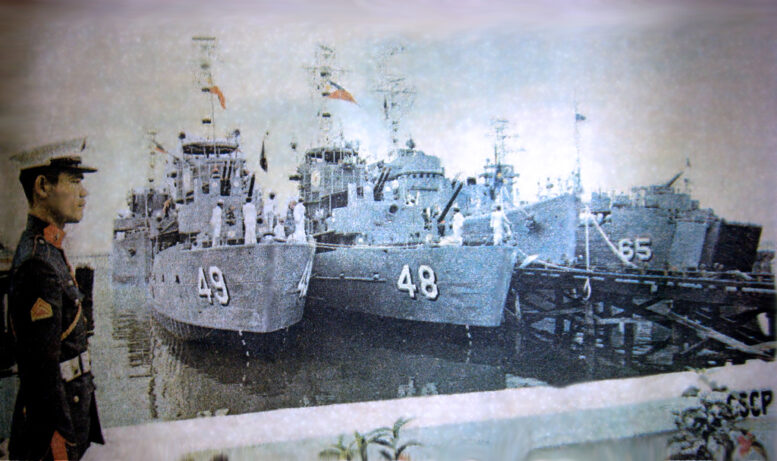Four years ago, in January 2019, news reports came out that the United States Army would divest its Maritime Capability beginning with 18 of its 35 large Runnymede Class Landing Craft Utilities and one of its 8 Frank S Besson Class Landing Support Vessels (LSVs), 2 of which were already in service with the Philippine Navy as the Bacolod City Class LSVs for which the original acquisition program began during the late President Corazon C Aquino’s term but were delivered during late President Fidel V Ramos’ term.
The U.S. Army planned to replace these ships with a new type of vessel. However, things took a different turn six months later in July 2019, when it was announced that the ships would not be sold.
Local defense pages on social media have now called for the country to look into these ships for the Philippine Navy to upgrade our Amphibious Capability and for Humanitarian and Disaster Response mission platforms. With this in mind, here is a brief backgrounder about how our Amphibious Warfare Capability began.
The Service Squadron was a unit of the Philippine Fleet activated on 01-January-1950, under Commander Juan B Magluyan with 35 Officers and 362 Enlisted Personnel.
Its initial strength had 1 AM (Minesweeper-RPS Samar), 2 LSTs at large, 2 Landing Craft at large, 3 AGL-Lighthouse Tender-RPS Orchid, RPS Pearl Bank, RPS Lauis Ledge), and 1 YTL-Small Harbor Tug (RPS Ifugao ex-HMS Emphatic).
Upon activation of the Service Squadron, the Patrol Force (Offshore Combat Force) and Shore Stations (Naval Shore Establishment/Naval Stations) were placed under it.
When the U.S. Navy transferred its ships to us during the early days of the Post War Offshore Patrol and Philippine Naval Patrol, we maintained their names or hull numbers. It was only in 1953 upon orders of Commodore Jose Francisco that our ships became Filipino-oriented, replacing the American names and hull numbers.
The Service Squadron is organized into 3 groups:
- The Transport Service comprising the Landing Ship Tanks;
- The Auxiliary Service composed of the Oil Tankers, Water Tenders and Tugboats; and
- The Special Service with the Presidential Yacht, FOIC’s Barge, and other smaller vessels.
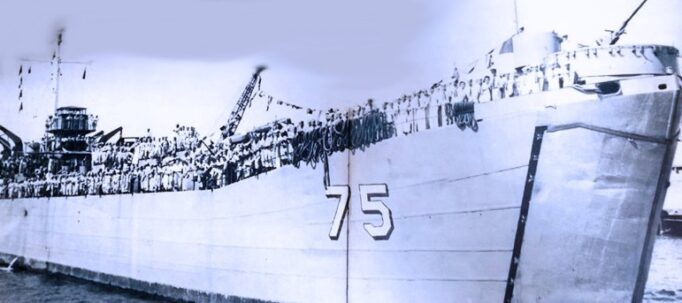
RPS Cotabato (T-36)
LANDING SHIP TANKS (LSTs). The Service Squadron commissioned its first 2 Landing Ship Tanks on 30-December-1947 as LST-75 or Ex-USS LST 75 later becoming RPS Cotabato (T-36), the 1st of the five (5) LST-1 Type in our inventory; and LST-865 or Ex-USS LST–865 later becoming RPS Albay (T-39), the 1st LST-542 Class in the Fleet.
They were followed by former USS LSTs 842, 843, and 875 (RPS Pampanga T-37, RPS Bulacan T-38 and RPS Misamis Oriental T-40. By 1969, 2 more 542 Class and 1-491 Class were added becoming RPS Cagayan (LT-97), RPS Ilocos Norte (LT-98), and RPS Bataan (LT-85, Ex-USS Caddo Parish). RPS Cagayan provided Combat Service Support to the Philippine Troops deployed during the Vietnam War.
Three years later, another shot in the arm was added with the commissioning of RPS Mindoro Occidental (LT-93), RPS Surigao Del Norte (LT-94), and RPS Surigao Del Sur (LT-95) on 15-July-1972. All three are former U.S. Navy units.
By the end of the Vietnam War, with units of the former South Vietnamese Navy (SVN) under Captain Khung HuUm Ba and Captain Kiem Do that arrived in Subic Bay, most of their warships were turned over to the Naval Defense Force (Philippine Fleet) by the end of 1975 until 1976.
Ten (10) LSTs of the former South Vietnamese Navy Task Group II and Task Group III acquired by the Philippine Navy from 1975 to 1976.
- RPS Agusan Del Sur (LT-54)
- RPS Sierra Madre (LT-57)
- RPS Kalinga-Apayao (LT-516)
- RPS Zamboanga Del Sur (LT-86)
- RPS Cotabato Del Sur (LT-87)
- RPS Tarlac (LT-500)
- RPS Samar Oriental (LT-502)
- RPS Lanao Del Sur (LT-503)
- RPS Lanao Del Norte (LT-504)
- RPS Leyte Del Sur (LT-505)
Two (2) former Japanese Maritime Self Defense Force (JMSDF) units were also acquired in 1975 and 1976, becoming RPS Davao Oriental (LT-506, Ex-JDS Oosumi) and RPS Samar Del Norte (LT-510, Ex-JDS Shimokita).
By September 1976, 2 Ex-U.S. Navy units were commissioned RPS Cotabato Del Norte (LT-511) and RPS Tawi-Tawi (LT-512). By 13 September 1976, RPS Laguna (LT- 501) and RPS Benguet (LT-507) entered service. Standard Armaments were usually 8-40mm AA Guns. These are currently the last 2 LST types in commission with the Sealift Amphibious Force (SAF), along with BRP Sierra Madre (LT-57) serving as an outpost on the West Philippine Sea.
LST OPERATIONAL HISTORIES. Following are the available operational missions recorded and conducted by some of the LSTs that we have in inventory.
TO THE SHORES OF PUSAN. The first 5 LSTs bore the brunt of Combat Service Support for Philippine Expeditionary Force To Korea (PEFTOK) troops during the Korean War. The 5 Landing Ship Tanks (LSTs) of the Philippine Navy’s Service Squadron: RPS Cotabato (T-36), RPS Pampanga (T-37), RPS Bulacan (T-38), RPS Albay (T-39), and RPS Misamis Oriental (T-40) would serve as the workhorse, transporting Filipino soldiers to and from Korea for five years.

RPS Pampanga (T-37)
| PHILIPPINE NAVY COMBAT SERVICE SUPPORT IN THE KOREAN WAR |
||
| PEFTOK BCT | TO KOREA | TO PHILIPPINES |
| 10TH Battalion Combat Team “ Steady On” (Motorized) | USNS SGT Sylvester J Antolak (T-AP-192) | LST 75 (RPS Cotabato T-36)
LST 843 (RPS Bulacan T-38) LST 842 (RPS Pampanga T-37) |
| 20TH Battalion Combat Team
“ We Lead” (Motorized) |
LST 75 (RPS Cotabato T-36)
LST 842 (RPS Pampanga T-37) |
LST 843 (RPS Bulacan T-38)
LST 865 (RPS Albay T-39) LST 875 (RPS Misamis Oriental T-40) |
| 19TH Battalion Combat Team
“ Bloodhounds’’ (Motorized) |
LST 842 (RPS Pampanga T-37)
LST 865 (RPS Albay T-39) |
LST 842 (RPS Pampanga T-37)
LST 865 (RPS Albay T-39) |
| 14TH Battalion Combat Team
“ The Avengers’’ |
LST 843 (RPS Bulacan T-38)
LST 865 (RPS Albay T-39) |
USS Logan (APA-196) |
| 2ND Battalion Combat Team
“ BLack Lion’’ |
USS Mountrail (APA-123) | USS General SD Sturgis (AP-137)
USS General R.L. Howze (T-AP-132) USS General WH Gordon (T-AP- 117) LST 875 (RPS Misamis Oriental |
The first 5 LSTs were decommissioned during the 1970s to the 1980s. RPS Albay (T-39) also hosted the trial of Hadji Kamlon. RPS Misamis Oriental (T-40) was the First Philippine Navy vessel to haul war reparations in Japan on 15-January-1948 skippered by LCDR Jose Mabugat PN with Executive Officer ENS Siacunco PN.
FROM SHANGHAI TO MECCA. RPS Bulacan (LT-38) under LCDR Basilio Manigbas PN would be in the thick of evacuation mission of Filipinos from mainland China during the communist takeover of Shanghai in 1949. In August 1948, RPS Albay (T-39) with LCDR Florentino Buenaventura PN at the helm took Filipino Muslims to Mecca with Senator Tomas Cabili on board. RPS Albay’s Executive Officer is the first Filipino Muslim Naval Officer LT Tandiko Centi.
The first 5 LSTs arrived in 1947 and it would take 22 years for the LSTs to be augmented. After the fall of South Vietnam, a surge of LSTs joined the fleet from the defunct South Vietnamese Navy with a few units from the JMSDF and USN. They were the last World War II LST types received by the Philippines as Military Assistance Program or transfers.
VIETNAM WAR COMBAT SERVICE SUPPORT and EVACUATION MISSION
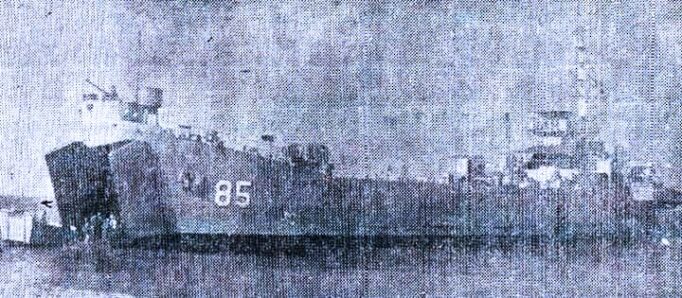
RPS Bataan (LT-85)
RPS Misamis Oriental (LT-40), RPS Bataan (LT-85) and RPS Cagayan (LT-86) were the known LSTs that were utilized by our troops “PHILCAG ” and during the evacuation of Da Nang and Vung Tau in the closing days of the Vietnam War. As early as 29-March-1975, RPS Bataan (LT-85), which was moored at Da Nang Harbor was tasked to evacuate 2, 500 South Vietnamese Refugees from Da Nang to Saigon along with 118 Filipino Workers. She was skippered by LCDR Jovito Camcam PN.
The Communist Forces were approaching the coasts and our sailors were told to unleash all the firepower that the ship had. If ever the enemy approached, they were to protect the civilians. The LST Officers and men were ready to shoot it out to protect their passengers, as all the 50 Calibers and Swedish Bofors were trained and pointed toward the Harbor Entrance.
On 27-April-1975, RPS Misamis Oriental (LT-40) under the command of LCDR Rafael Cartaciano PN evacuated 1,266 South Vietnamese and Filipinos to the Philippines. Full fire-power of the LST was uncovered to protect the its passengers.
ACTIONS UP NORTH AND DOWN SOUTH. RPS Cagayan was also used to ferry students for educational tours to Corregidor and was part of Task Force 32 during Operation “Pamukpok” off Lamitan, Basilan in July 1973. Concurrently, RPS Surigao Del Sur (LT-95) sealifted 19,000 cartons of medical kits for the Central and Southern Philippines in 1973. RPS Surigao Del Norte (LT-94) under LCDR Armando Calvo PN was also used in the anti-piracy campaign nabbing 23 fishing boats from Taiwan and Japan in cooperation with RPS Leyte (PS-30) commanded by LCDR Ramon Genoveva PN on September 1973 around Batanes and Babuyan Islands. Prior to her Vietnam exploits, RPS Bataan was with the Control group during Amphibious Operations off Siasi Island as part of Operation Batikus as well as clearing operations of Sanga-Sanga Island from 7-31 March-1976.
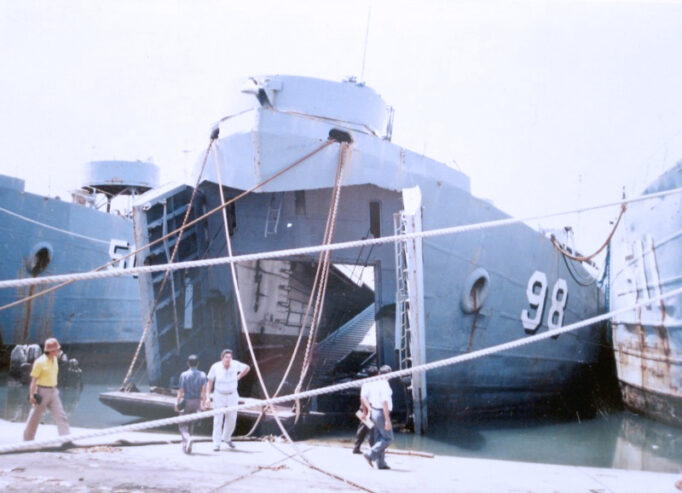
RPS Ilocos Norte (LT-98)
RPS Ilocos Norte (LT-98) carried the elements of the 1st Marine Battalion Landing Team on 04-February-1974 off Maimbung, Jolo, Sulu during Operation “Eagle Bay.” BRP Aurora and BRP Tarlac were part of the Search and Rescue (SAR) effort for the ill-fated Destroyer Escort BRP Datu Kalantiaw (PS-76) that sunk off Calayan Islands in 1981.
THE LANDING SHIP MEDIUM (LSM). Our first LANDING SHIP MEDIUM joined the fleet on 15-September-1960 when the former USS LSM-236 became the first RPS Batanes (LP-65). She was followed by RPS Isabela (LP-41) on March 1961 and the following year by RPS Oriental Mindoro (LP-68). Thirteen years later, two former units of the South Vietnamese Navy were turned over and the ex-RVNS Huong Giang became the 2nd RPS Batanes after LP-65 ran aground in 1970, while the other unit was used as spare parts source and was never commissioned. The last LSM to join the Sealift Amphibious Command (SAC) was RPS Western Samar (LP- 66) former RVNS Hat Giang in November 1975. By 1985, only RPS Isabela LP-41 and RPS Oriental Mindoro LP-68 were extant. Most were armed with 2-40mm AA Guns and 7-10 20mm AA Guns.
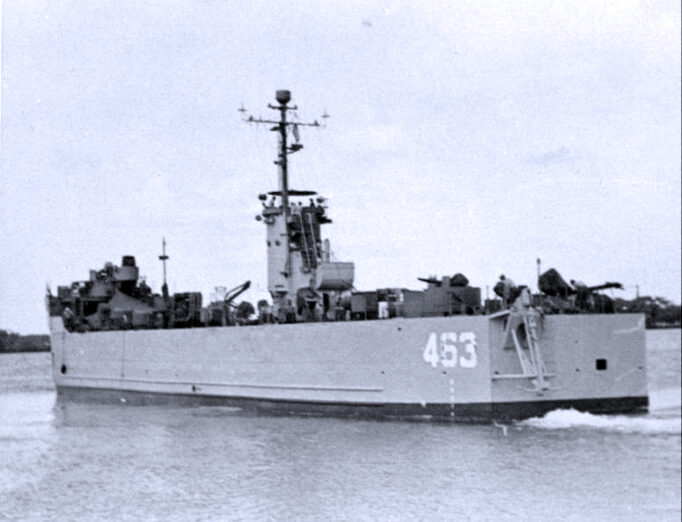
RPS Isabela (LP-41) Ex-USS LSM-463
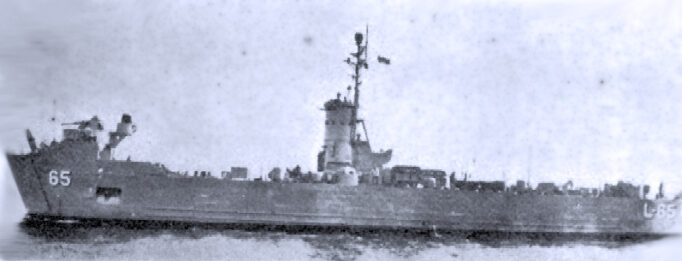
RPS Batanes (LP-65)

RPS Oriental Mindoro (LP-68)
LSM OPERATIONAL HISTORY. The LSMs were utilized in the Naval Gunfire Support and transport roles specifically during the height of the southern campaign, notably during Operation Pamukpok. RPS Oriental Mindoro in 1971 embarked and distributed 636,976 pounds of food, goods and medical stuff at Polilo Island, Quezon Province under LCDR Federico Lardin PN through the National Disaster Control Center of the DSWD, PRC, DOH and U.S. Catholic Conference Group. LP-68 was also with the Administrative Group (Task Group 32.10) during Operation Batikus. In 1966 RPS Isabela (LP-41) under LT Godofredo Calazan PN apprehended 5 Taiwanese Fishing Boats with Illegal entrants off Fuga Island, Batanes. RPS Western Samar was briefly used as a Floating Medical Facility.

RPS Sorsogon (LF-37) Ex-South Vietnamese penant 329
THE LANDING SHIP INFANTRY LARGE (LSIL). The LSILs of the SAC were former South Vietnamese and Royal Cambodian Navy Units that escaped their respective countries after the Vietnam War. The first to join was RPS Marinduque (LF-36, Ex- P111 of the Royal Cambodian Navy). She was followed by RPS Sorsogon (LF-37), RPS Camarines Norte (LF-52) and RPS Misamis Occidental (LF-53) all former South Vietnamese Navy units and lastly an Ex-Cambodian Navy LSIL that was not commissioned but used as spare parts source for the fleet. All four LSILs were decommissioned in 1980.

RPS Sulu (LF-49) and RPS Camarines Sur (LF-48). Photo Credit: Philippine Daily Express, Feb. 8, 1977
LANDING SHIP SUPPORT LARGE (LSSL): FIRE SUPPORT SHIPS. Three LSSL’s joined the SAC in 1975 and again all were former South Vietnamese units, RPS Camarines Sur (LF-48), RPS La Union (LF-50) and RPS Sulu (LF-49) all three were commissioned on 06-February-1977. One other Ex-RVN unit was used as spare parts source. By the last quarter of 1975, two Ex-U.S. Navy units were transferred but were never commissioned. All 3 units served for about 3-5 years in the fleet, mostly decommissioned during the early and late 1980s.
SOURCE OF IMAGES:
Navsource.org, Janes Fighting Ships 1968-69, Philippine Daily Express 1977.
About the Author
AUX CDR Mark R Condeno PCG is the On-Site Officer in Charge of the Philippine-Korea Friendship Center and Museum Curator of the PEFTOK Korean War Memorial Hall, Department of National Defense-Philippine Veterans Affairs Office. He holds a BS degree in Architecture from Palawan State University. He completed the Basic Naval Reserve Officers Training Course with the 420TH NROTCU. He is with Bravo Class of 1999, the Philippine Coast Guard Auxiliary Officers Indoctrination Course, Coast Guard District-Palawan. In 2002, he took the Aerospace Power Course at Air University, United States Air Force and is a 2008 Graduate of the Joint US Military Historical Operations Course. In 2007, he was Research Officer at the Office of the Naval Historian, PN. Lastly, he is with Class 26 of the Executive Course on National Security of the National Defense College of the Philippines.
